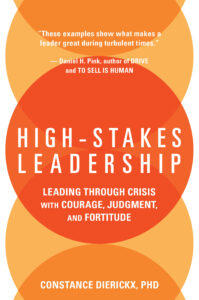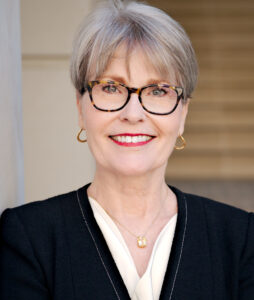Become a High-Stakes Leader
When the stakes are high, that’s when we need the very best in leadership. Why do some leaders succeed and others fail? Why do some not only survive a crisis, but use difficulty to produce incredible results?
These questions are tackled by Constance Dierickx, PhD in her new book, HIGH-STAKES LEADERSHIP: Leading Through Crisis with Courage, Judgment and Fortitude. She shares how to lead with the type of courage that makes you stand out.
I recently asked her to share her insights on high-stakes leadership.
What do you mean by High-Stakes leadership?
A high-stakes leader is someone who is successful when risk is high and visibility is low. New ventures are an example, whether they are for a new product, service, geography or method of production. Top leader changes, mergers and crisis are also examples of high-stakes situations.
Leaders who get good results achieve value on multiple fronts. As Jim Kennedy, Chairman of Cox Enterprises says, “It can’t be just about the money.” In a crisis, we need only compare the recent leadership failure at Equifax with the response of The Home Depot in a similar circumstance, a breach. The response of these two companies was wildly different. Frank Blake’s actions are a model of what to do.
My book talks about what leaders in high-stakes situations should do and provides examples from a wide range of organizations. I also talk about what gets in the way of leaders. Invisible traps include the human cognitive system, which is not a completely rational system. Our human limits lead us to make mistakes that may look foolish but can be the result of cognitive limits, the effect of emotion on decisions, the context or our own habits of avoiding anxiety.
There is an additional factor, which I include in my forthcoming book Breaking Up Is Hard to Do, in which I focus on mergers, acquisitions and divestitures. That is when we wrongly assign value to opportunities, risk, timelines, market size, and so forth. It’s one thing to think something is low risk and be right and quite another to believe risk is low when it isn’t. Even smart people can be blind when making evaluations, a part of leading. We don’t have measures for everything, and even when we do we aren’t always measuring what matters.
Perhaps the greatest risk of all is in thinking we are operating in a safe zone and being complacent.
What insights did you gain early on in your career when working as a broker at Merrill Lynch?
My experience as a broker was what made me aware that people can be irrational even when they appear the opposite. When our money is at stake, we can be very illogical but are usually loathe to admit it, even to ourselves. I had a college professor client who thought he’d “cracked the code” on investing and was as bombastic as our most extreme stereotype of his profession. He dismissed my attempts to dissuade him from trying to time the market. He took major losses but never wavered in his beliefs, despite evidence to the contrary.
My insight broadened when I realized that it wasn’t just my clients who were irrational. My colleagues weren’t much better at applying discipline to at least reduce the effect of emotion on decisions. They made major errors in judgment. Seeing this was scary. I wondered how a mere human and a college dropout could hope to do right by my clients in this environment. I started reading everything I could get my hands on about decision-making and psychology. Humans as rational actors didn’t make sense to me, though I was a long way from reading Kahneman and others who have shed light on this very topic.
Talk a little about the interplay between courage, fortitude, and judgment.
Each of these three elements makes the others more valuable. Courage and judgment can lead us to do the right things very well but without fortitude, the effort will not be sustained. Judgment and fortitude without courage makes one very reliable and perhaps honorable but not innovative. Courage and fortitude without judgment may make us bold, energetic and determined but not necessarily in the right direction.
Courage energizes the other two aspects. Judgment helps us make better decisions even if that is to pull the plug on something or pause before we act. Fortitude sustains us, helping us when the excited energy fades. Fortitude is what helps us do the boring thing or the thing we have rationalized away but is essential.
Learn to Be Courageous
What’s the best way for someone to learn to be more courageous?
Three ways: 1. Be with others who are courageous. Courage is contagious but so is recklessness, which is why you need the other elements. 2. Look for a mentor who is courageous and who believes in you enough to push you. My best mentors and teachers have all been courageous people. They pushed me toward my vision, not theirs. 3. Look for what you need to shed, not just what you need to acquire, learn or build up. It takes courage to let go of long-held ideas, habits, friends and even family members. People carry around too much baggage, mostly guilt. What we need to truly thrive and share our talents is autonomy. Too many give it away in favor of safety or habit, which is another way of saying to avoid anxiety.
You spend time talking about the dangers of overconfidence. How does someone recognize this?
Two ways. The first is preventative. This is far better than corrective. It saves a lot of time and frustration. Knowing that humans are fallible means accepting that about ourselves. This takes an intellectual understanding into the domain of personal knowledge. That can be very hard. I often tell audiences that knowing what I know about cognition, emotion and decision-making doesn’t mean I’m immune. Yet, accepting that we can, and will, make mistakes keeps us from climbing up on our own pedestal as often as we might. Charlie Munger is known to review examples of mistakes made by leaders as a way to keep him grounded. No rational person would doubt his capability.
If you and your colleagues can entertain the idea that your assumptions, conclusions, evaluations, and decisions may be wrong, that’s a good thing. Ask the question: what if we are wrong? Think but then act. You won’t be right all the time.
The second way is corrective. If you set out on the wrong road, you need methods to give you early information. You want to fail quickly and cheaply. Failing isn’t fatal unless you ride the decision that led to it all the way to the bottom. If you are a leader and no one around you will tell you when your ideas stink, you have a problem. If you are so busy staring at spreadsheets that you only know the tide is in when your feet are wet, you have a problem.
Mistakes will happen. When it’s a pattern, there is more going on than the invisible decision traps to which we all are subject. That is an issue of capability.
Brene Brown has spoken and written on vulnerability and leadership. What’s your view of vulnerability for today’s leader?
It’s vital. We cannot learn if we aren’t vulnerable, and learning continuously from many sources is an attribute of great leaders. If a leader isn’t learning, they aren’t modeling it and encouraging others to do it with any semblance of credibility. Part of learning is letting go of what we thought five minutes ago.
To avoid exposing uncertainty, inconsistencies or mistakes, some people can be quite aggressive and argumentative. They protect themselves from unpleasant feelings, and for many, vulnerability breeds fear and anxiety. Brene’s work explores the struggle we have with vulnerability and why it matters that we don’t push the concept aside.
Would you share the Fortitude Formula with us and how it’s used?
Vision + Mission + Persistence x Character = Fortitude
Vision is a picture of a desired future state. It’s a person’s or organization’s North Star and helps them know who they are and make decisions that reflect their purpose. Mission answers the question “Why do we exist?” Persistence is akin to what Angela Duckworth calls Grit. It enables people to sustain effort toward goals that are difficult, take time or both.
Character is the final element in the formula, and it is the only one that is not additive. It is a multiplier. Vision, mission and persistence can serve a nefarious goal or a laudable one. The quality of one’s character makes the difference, and the character of the leaders needs to be more like Warren Buffett and Frank Blake than Ken Lay.
I use this model to think about businesses. A few questions that help me are:
Does the strategy of the company make sense?
How much traction does the business have? Why or why not?
Are the leaders right for this situation?
What’s your view of leadership in the future?
 We need to throw out the phrase “I’m open to learning new things.” First, most who say that aren’t. Second, leaders must do more than be open to learning. Leaders must create the conditions for learning to occur for themselves and others. This is at the top of my list because the world is changing fast, organizations are becoming more global in reach and conversely, events around the world have far reaching impact. Leaders need to have breadth of knowledge about people, events, risks and possibilities as they affect both opportunity and danger.
We need to throw out the phrase “I’m open to learning new things.” First, most who say that aren’t. Second, leaders must do more than be open to learning. Leaders must create the conditions for learning to occur for themselves and others. This is at the top of my list because the world is changing fast, organizations are becoming more global in reach and conversely, events around the world have far reaching impact. Leaders need to have breadth of knowledge about people, events, risks and possibilities as they affect both opportunity and danger.
The ability to learn extends well beyond taking in new information. Adding facts to a rigid paradigm doesn’t enable the type of thinking most company’s need. Hiring people based on what you really need, rather than what you have traditionally sought, is another way to accelerate learning for an entire business. This requires leaders to genuinely understand their people beyond what they can do right now. What are they great at? What do they want to learn? Few leaders ask these questions but when the stakes are high, you can’t afford to overlook talent of any sort.
For more information, see HIGH-STAKES LEADERSHIP: Leading Through Crisis with Courage, Judgment and Fortitude.

